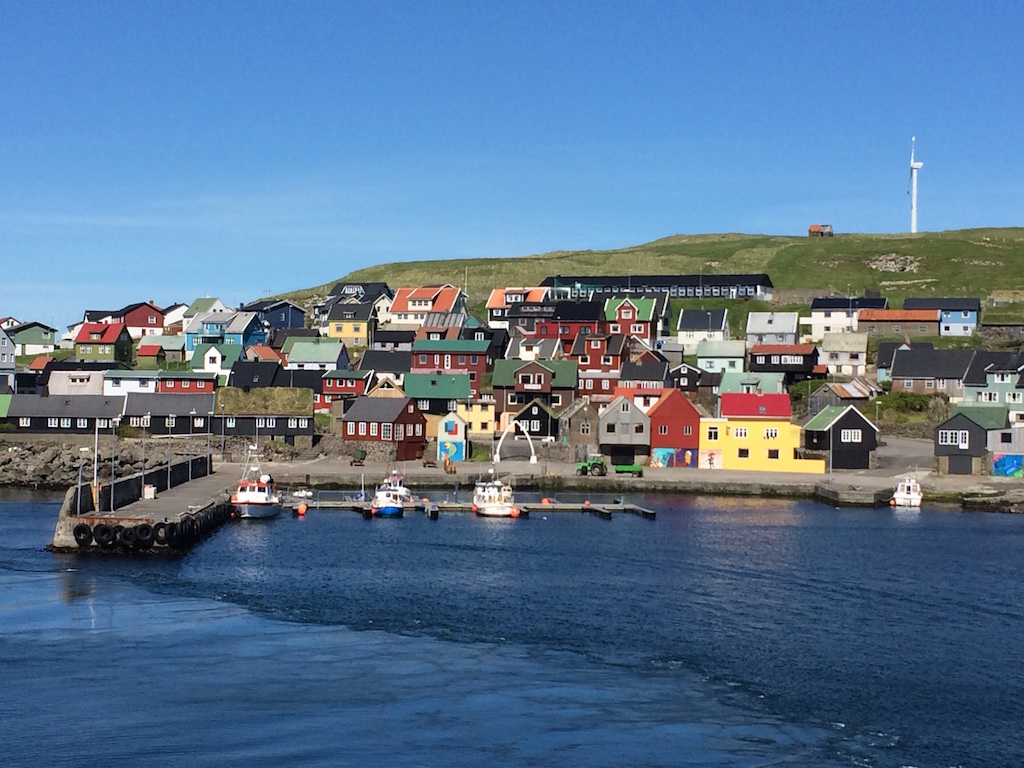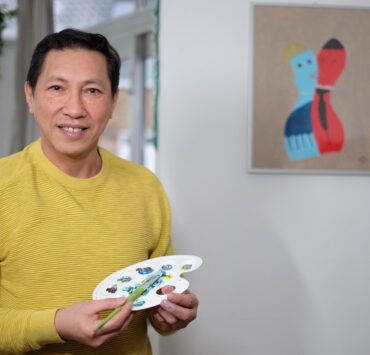I didn´t have a clue where the Faroe Islands was. But an advertisement popped up on my Facebook one day promoting a small-scale marathon in Tórshavn, somewhere in the North Atlantic Ocean. I grew up on a small island in the Philippines, I am naturally drawn to remoteness. Combining this with my great interest at that time, running, I was ready to pack my bags right away.
More sheep than humans
Called Føroyar in local language, Faroe Islands is an archipelago nestled in the centre of the North Altantic triangle of Scotland, Iceland and Norway. It is an autonomous region under the Danish Kingdom and consists of 18 islands, 17 of which are inhabited. Unless you are fond of sheep or cruises, you probably have not heard of this place either.
Faroe Islands has a population of 52,122 people and 70,000 sheep, and a popular stop-over for cruise ships plying the Norwegian-Iceland cruise lines. Tourists come for the waterfalls and the puffins. I however came for two things: to run Tórshavn Marathon and eat at Koks Restaurant, back then a relatively new name following the foraging footsteps of Noma’s Chef René Redzepi in Denmark.
What I discovered is a place of kindness where people and nature coexist in a mutual symbiosis.
“It is exceptionally warm for June, you’re lucky,” said my business acquaintance, Karl Reynheim, whom I met for the first time. He kindly offered to pick us up from the airport and take us to our accommodation. I was expecting a chilly, windy day and an overcast sky, but the sunny weather was a welcome surprise.

Temperature on the Faroe Islands does not exceed 11 degrees in the summer, and it usually rains half of the month. Karl thought I was crazy to run the Tórshavn Marathon but even crazier to eat at Koks. “That’s only for rich people,” he said, citing the exorbitant price of the food. Instead, he encouraged me to try the more authentic local restaurants at the centre of Torshavn.
Our conversation turned from elitist restaurants to the local cuisine. Being more direct than I was, my Dutch husband asked him, without qualms, about the Grindadráp, (recently popularized by the documentary Seapiracy), Faroese summer tradition of killing whales and dolphins. Without sounding defensive, he explained that the agricultural situation on the islands is not comparable to farming countries.
“Try saying to an African or Eskimo that you are a vegetarian, that you don’t believe in killing animals for food,” he chuckled. “We had to do with what we have, sheep, whales, fish,” he added, citing the island’s soil is not particularly arable because of the constant beating of the brutal North Atlantic wind.
Looking out his car window, I noticed something glaringly absent in the landscape, trees. I understood what he meant. Only 2% of the Faroese territory is cultivated, and what grows there are usually root crops which are not easily blown away by the hurricanes that batter the island all year round. He was worried about the young people leaving because the island is too small for agood education system. He also blames the excesses of modern life for this diaspora. But he was glad that the gulls (fulmars) are coming back.
I thought I would never see Karl again after he dropped us of at the Air B&B. But he was cheering for us at the finish line of the Tórshavn Marathon. When he learned that we had very little time to catch our reservation at Koks, he generously drove us to our lodging so that we did not have to walk anymore after running five hours of punishing hills.

Island Hopping
It felt like midday at half past six in the evening. When we arrived at the guest house of Sámal and Tórhada in Tórshavn, the smell of dried fish welcomed us, a familiar smell from my childhood in Marinduque. Tórshavn, located on Streymoy, is the smallest capital in the world. A picturesque little city with Nordic-style colorful houses dotting the harbor area which is also the docking place of cruise ships.
What made a lasting impression on me was the verdant grass on its famous grassroof houses, like a meticulously maintained English lawn, owing to 300 days of rain on the islands and the hard-working flocks of sheep whose jobs are to mow these roofs.
On a Thursday evening, you would hardly say that 19,000 inhabitants live here, making Tórshavn the mostly populated in the whole of Faroe. The most crowded area we saw was on the cathedral steps at Bryggjubakka, where about 30 people were enjoying the generous evening sun near their beautiful port. At one in the morning, a faint strip of orange was still visible in the midnight sky. The sun was about to rise at 4am. The drowsiness of sleep came but a proper shut eye was impossible. And for an amateur runner, losing sleep before the marathon was an awfully bad thing.

From the Tórshavn harbour, a 20-minute ferry crossing took us to the nearest island of Nólsoy which was not as popular as the other islands. With a total size of 10 square kilometers and a population of less than 250 people, it was easy to roam about without seeing a single soul nor a single tree. The barren, ruggedness of Nólsoy, devoid of greenery and with three rising, rocky cliffs surrounding it, can easily be dismissed as ugliness. But this is exactly what makes Faroe Islands unique, its rawness, its complete surrender to the elements, and its ability to create something beautiful from the abundance that nature deprived them.
While hiking to Eggjarklettur, the highest peak on the island, we saw hundreds of European storm petrels, a kind of seabird, flying low above yellow flowers, making panic noises. Perhaps they were disturbed by our presence, two strangers trying to get closer for the obligatory photos. We felt like intruders.
On the contrary, the puffins at Mykines were more accommodating. Maybe because they are already used to nosy tourists, so you could get close without them flinching. The day after the marathon, which we fortunately survived with a satisfying finish, we went on another island tour, this time to Faroe’s most famous islands. Mykines is grassier than Nólsoy, bigger, higher and has steeper cliffs, the perfect backdrop for those death-defying travel photos on Instagram.

Humans, and sheep falling off the cliffs is common on the Faroe Islands. Yet you will not find any warning signs nor safety rails holding off unsuspecting tourists. Maybe the Faroes have as much faith in people’s common sense as they do with nature.
The ferry trip from Sørvágur to Mykines was about 45 minutes but the view of mighty cliffs rising above the North Atlantic Ocean, of giant rocks which felt like they were about to swallow me whole, betrayed the passing time. Dots of colorful houses were visible from the far-off coastlines. I wondered how people traveled back to their homes after a day working in the capital, trivial musings of someone who is so used to the urban life. Many Faroese inhabitants, especially the older ones do not see the need to leave their homes. The islands, their sheep, their fishing, are their entire lives.

But some search for their destiny in distant places, like the retired seaman walking his dog in Sandavágur. He stopped to chat with us while we were enjoying the tranquility of the lake.
At 17, he joined a sea-going vessel and spent his entire life travelling around the world. He told me that he had been to Batangas, that he loved it in the Philippines.
After a while, another local approached us and offered us to partake from his stash of Royal Export beer. He hardly spoke English, but we found out that he was a hobby photographer. We also tried hitchhiking on our last day when we missed the last bus to Tórshavn.
A friendly lady who was heading to the same direction pulled over, all too willing to let strangers into her car and drive them to the capital.
Faroese are one of the kindest people I have known, and this reflects in their way of lives. Homes are not usually locked; street crime almost never happen and there is no prison on the island.
An extremely expensive meal
In 2015 Koks was located on a hill in Kirkjubøur, still in Streymoy but accessible only by car. The breath-taking view of the water stretching to Koltur and Hestur islands was a balm to our aching bodies, tired from the marathon. They did not have a Michelin star yet, but the menu was already priced in the fine dining category. The exclusivity appealed to me.
What can you expect to eat at Koks? They are serving the Faroese lifestyle in bit-size pieces. Cod, two pieces of scurvy leaves, lamb heart, clams, mussels, nettle leaves, fermented lamb meat, moss, seaweed, langoustine, skate, and sharks, freshly caught, pickled, fermented, or dried, brought in the most unique serving vessels (including stones and moss), making them appear tinier than they already are.
The waiters explain each dish extensively, so you need a pen and paper (or a recorder) to remember all of them. However small the servings are, you will not leave the restaurant hungry because there at least 14 dishes in the tasting menu. None can be ordered separately. Four years later, Koks got two Michelin stars. Currently the tasting menu for one person at Koks cost around €250 without drinks.

This amount might sound ridiculous. But an army of young and proud Faroese shared their scant food resources to me, prepared in tasty elegance and served most thoughtfully. On top of it, a shark was killed for my dining pleasure. Surely this should not come cheap.
It is hard to choose what I enjoyed best on the Faroe Islands, the marathon, our dinner at Koks, or the afternoon at the lakeshore of Sandavágur, casually chatting with the locals. It is not surprising how easily I connected with the remoteness of the Islands and the simple lifestyle of its people.
Small islands have always been my escape from the chaotic, hurried pace of city life, whether it is in theNetherlands, in the Philippines or further away in Faroe. I will not forget her barrencliffs, the stinging aftertaste of eating weeds and rotten fish meat, and that liberating sensation of being so far away from it all.
This article was first published in the 2021 Summer Issue of The FilipinoExpat Magazine.




